WML ANNUAL REVIEW 2005-06NOTABLE CONSULTATIONS & COLLABORATIONS
|
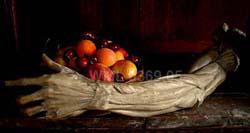 |
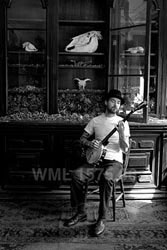 |
 |
Visitor numbers have increased during the year - at the Annual Opening, during Opening Hours, and via the website. It has been the Library's busiest year to date and, in response, the Keeper has produced an Annual Review, providing a synopsis of some of the WML's most notable Consultations and Events which took place from Spring 2005 - Spring 2006:
MARCH 2005
In March 2005 Jane Wildgoose was invited to Coppetts Wood in Hertfordshire to give a talk about her role as Keeper of The Wildgoose Memorial Library at a branch meeting of The British Institute of Funeral Directors. Jane outlined the origins and development of the WML: recounting how she had formalised the Library as part of the research for On One Lost Hair, for BBC Radio 4 - in which she and Gregory Whitehead pondered the significance and fate of a strand of hair from Nelson's head, purchased on eBay. Despite some apprehension that she might be bringing coals to Newcastle, Jane showed the meeting the miniature replica of Nelson's coffin that she had made to house the hair on a final journey on the River Thames - and was pleased to discover that the little casket was enthusiastically received by the professionals.

The Keeper was joined by an invited group of Readers in March 2005 for the Annual WML Valedictory Dinner, marking the end of the WML's formal 'Opening Hours', for another year. Mural painter Tony Raymond (whose work features on one of the WML ceilings), was Guest of Honour in recognition of his exemplary role as a donor of Ingenious Curiosities to the Collection. Tony's numerous gifts to the Library, which include examples of idiosyncratic - though none the less important - ephemera, from the studio of the late Barbara Jones (author, Design for Death, 1967), have added depth and levity to the WML's Archives in equal measure over a period of many years.
Also present was Dr. Peter Isaacs, visiting from Blackpool Victoria Hospital. Dr. Isaacs is Principal Advisor to the WML on Medicine & the Body, and also collaborated with Jane Wildgoose on the medical and musical performance project Viewing the Instruments.

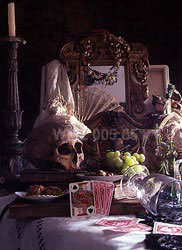 |
| (Click on images to enlarge) |
John generally works outdoors, concentrating on landscape, but for this exhibition he had decided to develop a still life painting. Feeling that the atmosphere of the Library would be conducive to his thoughts about Lampedusa's work, John requested that Jane Wildgoose should assemble a still life installation for him to paint that would attempt to capture the dream-like atmosphere he had encountered on a recent research trip to Palermo, as well as suggesting some of the elegiac qualities of The Leopard, written during the last year of Lampedusa's life.
Drawing on Vanitas themes she found in the book, Jane created an emblematic composition incorporating artefacts John had brought back from Sicily, together with objects from the WML Collection, and a number of items generously loaned by Andrew Sorrell of Floral Hall Anitques, London N8. Over a period of several weeks in the Spring of 2005 John made daily visits to the Library to work on the painting, which was subsequently exhibited in the Lair of the Leopard exhibition at Francis Kyle, and featured again in John's one man show at the gallery in November 2005.

APRIL 2005
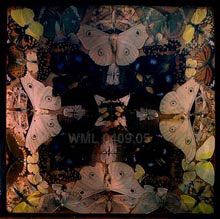 |
| (Click on images to enlarge) |
Clare had recently donated a venerable pair of antlers to the WML Archives, accompanied by a curious item preserved in a jar and bearing the frankly dubious provenance: 'Deer Heart, Perthshire, c. 1926'. The Keeper wondered whether Clare might be able to provide a little more information about these objects? It was therefore with great pleasure that she subsequently received a further donation through the post: the short story, Deer Heart, specially written for The Wildgoose Memorial Library.

MAY 2005
Canadian artists Rebecca Duclos and David Ross, Directors of The Manchester Letherium Ideas Competition, made their first visit to The Wildgoose Memorial Library while en route home to their native Canada, following a sojourn of several years at Manchester University. During their stay Rebecca and David became the first Readers to sit for the WML Portrait Project [see Rebecca's portrait & David's portrait], and they kindly donated an edition of The Origins & History of the Manchester Letherium 1833-1940 (A. J. Samuels, Manchester Letherium Committee, 1999) to the Collection.

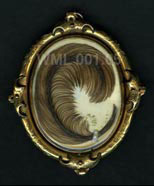 |

JUNE 2005
Playwright and radio producer Gregory Whitehead, visited the UK in June and made an appointment at the WML to meet with Jane Wildgoose to discuss plans for the radio piece, At Home in the Wildgoose Memorial Library, which is in production as part of Jane's NESTA Dream Time Fellowship 2005/06. Gregory kindly made a donation to the Collection of a fragment of hair from the head of Queen Victoria, recently purchased on eBay, as well as a selection of recordings of his audio work, and a signed first edition of Wireless Imagination: Sound, Radio and the Avant Garde (edited by Gregory Whitehead and Douglas Kahn, MIT, 1992).

Since June 2005, Textile Conservator Mary Brooks (Leader, Museum Studies MA, Southampton University) has made a number of visits to the Library in her role as Mentor to Jane Wildgoose under the provisions of the NESTA Dream Time Fellowship 2005-06 - a collaboration that has provided the forum for a series of valuable and thought-provoking consultations.
In July 2005 Mary referenced Jane's work from the exhibition Human Nature (Maidstone Museum 2004) in a paper* she presented at the Victoria & Albert Museum, London, as part of the conference Ways of Making and Knowing: the Material Culture of Empirical Knowledge, sponsored by the Yale Center for British Art and the Wellcome Trust.
(*Entitled: Decay, Preservation and the Making of Knowledge in Museums: Paradoxes and Contradictions).
During the year Mary has provided invaluable support to the WML, and been a source of great inspiration; the Keeper is also particularly indebted to her for timely advice on pest management in museums.

During the summer The Library welcomed Canadian artist Spring Hurlbut with photographer Arnaud Maggs, and the Keeper was privileged to be given a preview of some of Spring's most recent work. Spring has made a number of valued donations to the WML Collection since her first visit two years ago, including: a box of Victorian mourning pins with accompanying mourning stationery; a fine set of colourful Mexican 'Day of the Dead' paper cut-outs, and an edition of The Final Sleep/Le Dernier Sommeil, published to accompany Spring's installation of the same name at the Royal Ontario Museum, Toronto, in 2001.

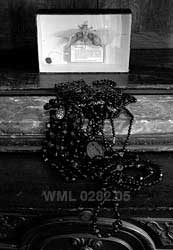 |

AUGUST 2005
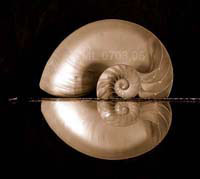 |
| (Click on images to enlarge) |

SEPTEMBER 2005
 |
| (Click on images to enlarge) |
Venu Dhupa (Fellowship Director, NESTA) attended the Opening, and enquired whether, as she was about to embark on a trip to India, she might make a donation to the Collection that would help in extending the WML's holding of artefacts from other cultures? It was therefore with great delight that, just prior to Christmas, the Library received through the post a beautiful small souvenir of the Taj Mahal. In an accompanying text, Venu detailed the Taj's history, together with a moving description of her experience of seeing the tomb for the first time - providing a keen incentive for the Keeper to visit India and experience this extraordinary monument for herself. Jane Wildgoose is grateful for this insight, and is now considering ways in which she may further develop the Collection's cultural diversity. She would like to extend her gratitude to Venu and her colleague at NESTA, Alex Barclay, for their enthusiastic interest in, and professional support of, The Wildgoose Memorial Library's development during 2005-06, while Jane has been funded by the Dream Time fellowship.

NOVEMBER 2005
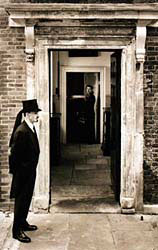 |
| © Harry Willis Fleming (Click on images to enlarge) |
Jane invited the audience to take tea by candlelight - to pause with her, and to consider the role of memorialisation, in contemplation of artefacts and ephemera from the WML Collection: a selection of mourning jewellery and stationery; a printed paper napkin dating from 1901 tracing the route of Queen Victoria's funeral procession; a framed 19th-century 'Coventry' ribbon featuring an intricately woven portrait of 'The Late Earl of Beaconsfield', and a series of In Memoriam cards, Victorian photographs, and funereally decorated certificates, documenting the locations of grave plots. Also offered for consideration were a number of contemporary artworks and stories received into the WML Archives over the past year. Jane finished her presentation by showing some of her recent portrait photographs of WML Readers, and still lifes of the collection, which she has been developing during her NESTA Dream Time Fellowship 2005-06, in which she has been exploring relationships between objects and memory.
A light (though none the less lugubrious) repast was served, including coffin-shaped gingerbread biscuits iced with white skeletons - baked specially for the event by Trust member Claire Aston - and a rich fruit 'Scripture Cake', made to an original Victorian recipe by John St Brioc Hooper. The afternoon concluded with viewing of the memorials in nearby St. Giles-in-the-Fields Parish Church, which was built in the Palladian style in the early 1730s to designs by Henry Flitcroft.

At the end of November 2005 Bergit Arends, Curator of Contemporary Arts at the Natural History Museum, London, made an appointment at the Wildgoose Memorial Library for a consultation about issues relating to human remains in museums.

FEBRUARY 2006
At the beginning of 2006 the WML received a commission from Brian Hurwitz (Professor of Medicine & the Arts, King's College, London) to produce an original photograph and associated ideas for a poster to advertise the College's new MA Literature & Medicine course. With a view to creating an image that would convey ideas about 'reading' the body as a 'text', Jane Wildgoose took up an opportunity to visit the Science Museum stores, where she met with an impressive array of antiquated mechanisms for making records of the body's functions. After some deliberation, she selected a kymograph* to be the principal subject of a still life photograph which she set up one overcast morning in February at the Museum's labyrinthine repository.
Jane Wildgoose would like to thank Robert Bud, Barry Marshall and Fran David at the Science Museum for their kind help and co-operation in providing access to the Kymographs and their records in the Science Museum's collection. (*Kymograph: an instrument for recording temporal variations of physiological or muscular process, employing a stylus that makes tracings onto smoked paper held in place on a revolving drum).

MARCH 2006
The year ended with the traditional valedictory dinner for invited Readers in March, as the commencement of Spring brought the end of formal Opening Hours for the Library for another year. The Diary remains open for appointments for collaborative projects throughout the year, and The WML Portrait Project continues, with American singer and blue grass banjo player William E Whitmore the most recent sitter in the WML.
WML Donors 2005-06
Consultations 2003-05

Copyright Jane Wildgoose and The Wildgoose Memorial Library